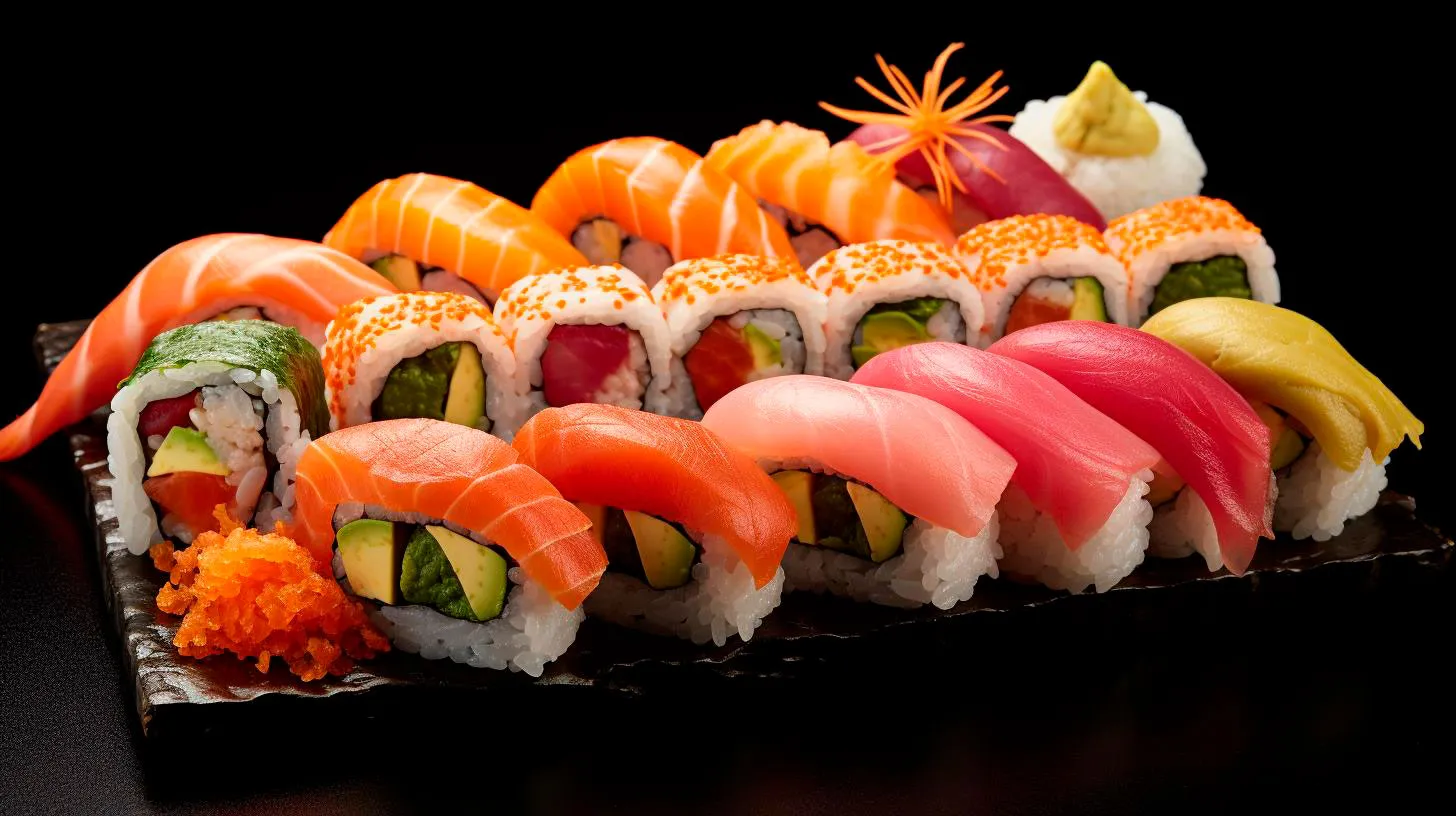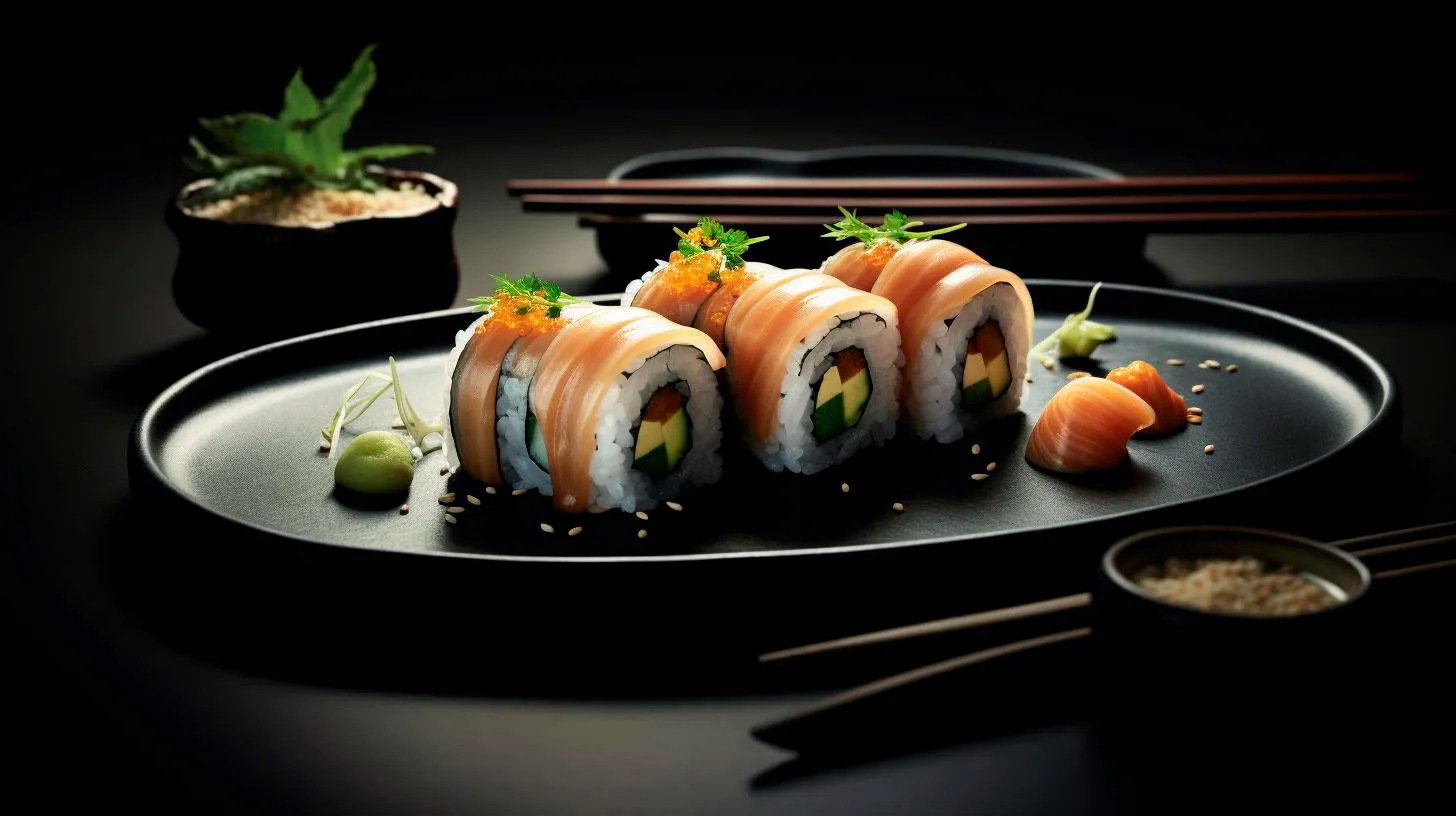Mastering the Art of Sushi Etiquette
By understanding and adhering to sushi etiquette, you can enhance your dining experience and show respect to the sushi chef. In this article, we will explore the key aspects of sushi etiquette and help you become a sushi connoisseur.
Why is Sushi Etiquette Important?
Before diving into sushi etiquette, let’s understand its significance. Mastering sushi etiquette allows you to establish a harmonious connection with the chef and others in the restaurant. It demonstrates your respect for the culture, traditions, and skills that go into crafting each sushi roll. Additionally, following proper sushi etiquette ensures that you are able to fully savor the flavors and textures of each piece, enhancing your overall dining experience.
Key Sushi Etiquette Practices
1. Handling Chopsticks
Chopsticks are a fundamental part of any Japanese dining experience, and sushi is no exception. Here are some essential tips for handling chopsticks:
- Do not use your chopsticks to point at others or wave them around.
- When not in use, rest your chopsticks on the provided chopstick holder or lay them horizontally on the plate.
- Never stick your chopsticks vertically into a bowl of rice, as this gesture is associated with funeral rituals in Japan.
2. Soy Sauce Usage
Soy sauce is an integral part of sushi consumption, but it is important to use it correctly:
- Pour a small amount of soy sauce into the shallow dish provided. Refrain from using excessive amounts as it can overpower the delicate flavors of the sushi.
- Dip the fish-side of the sushi into the soy sauce rather than the rice, as the rice tends to absorb excessive amounts of sauce.
- Avoid leaving half-eaten sushi in the soy sauce, as it is considered wasteful.
3. Wasabi Placement
Wasabi, a pungent green paste made from horseradish, is often served alongside sushi. Follow these guidelines for proper wasabi usage:
- Place a small amount of wasabi on top of the sushi, as it is already applied by the chef underneath the fish.
- It is acceptable to mix wasabi into soy sauce for dipping, but do so sparingly.
- Do not spread the wasabi directly on the sushi rice, as this is considered disrespectful to the chef’s mastery of flavors.
Benefits of Mastering Sushi Etiquette
Understanding and practicing sushi etiquette offers several advantages:
1. Enhanced Dining Experience
By following proper sushi etiquette, you can fully appreciate the intricate flavors, textures, and craftsmanship involved in each sushi creation. It allows you to have a more immersive and enjoyable dining experience.
2. Establishing a Connection
The sushi chef takes great pride in their art and appreciates when customers show respect for their culinary skills. By adhering to sushi etiquette, you can cultivate a positive connection with the chef, leading to a more authentic and personalized dining experience.
3. Cultural Appreciation
By mastering sushi etiquette, you demonstrate your reverence for Japanese culture and traditions. It also showcases your willingness to embrace and respect diverse customs, facilitating cultural understanding and appreciation.
Final Thoughts
Sushi etiquette is an essential aspect of enjoying this delectable cuisine. By familiarizing yourself with the key practices, you can demonstrate respect to the chef, enhance your dining experience, and deepen your understanding of Japanese culture. Remember, mastering sushi etiquette is not just about following rules—it is about immersing yourself in a centuries-old tradition and savoring every bite with gratitude.
The Ultimate Guide to Proper Sushi Etiquette
Whether you are a sushi enthusiast or a first-time sushi diner, it is important to familiarize yourself with proper sushi etiquette to ensure an enjoyable and respectful dining experience.
Why Does Sushi Etiquette Matter?
Sushi is not just a meal; it is an art form that has been perfected over centuries in Japan. Observing sushi etiquette is a way to show respect to the sushi chef, who has spent years mastering their craft. It also allows you to fully savor the flavors and textures of the sushi while maintaining a harmonious dining experience with your fellow diners. Understanding proper sushi etiquette will enhance your dining experience and help you immerse yourself in the rich cultural heritage of sushi.
Key Sushi Etiquette Principles
1. Chopstick Etiquette
- When using chopsticks, avoid rubbing them together as it can be seen as an insult to the chef’s skills.
- Do not wave or point with your chopsticks.
- Rest your chopsticks on a chopstick holder or the side of the plate when you are not using them.
2. Soy Sauce Usage
- When dipping sushi into soy sauce, lightly dip the fish-side only. Avoid soaking the rice as it can make the sushi fall apart.
- Avoid adding wasabi directly to the soy sauce dish. The chef has already carefully balanced the flavors.
- Use small amounts of soy sauce to avoid overpowering the delicate flavors of the sushi.
3. Sushi Ordering
- Order sushi in moderation to allow for a well-paced dining experience.
- Consult the chef’s recommendations to fully appreciate the seasonal and freshest selections.
- Refrain from asking for modifications or substitutions to the sushi unless you have dietary restrictions.
4. Eating Sushi
- It is customary to eat sushi in one bite to experience the harmonious blend of flavors and textures.
- Avoid using excessive amounts of wasabi or soy sauce that can overpower the taste of the sushi.
- Avoid mixing wasabi into the soy sauce dish, as it can alter the intended flavor balance.
The Benefits of Proper Sushi Etiquette
Adhering to sushi etiquette not only shows respect to the Japanese culture but also enhances the overall dining experience. By observing proper etiquette, you can:
- Develop a deeper appreciation for the craftsmanship and artistry of sushi.
- Enjoy the delicate flavors and textures of each piece of sushi.
- Create a harmonious atmosphere that fosters a positive dining experience for everyone.
Key Takeaways
Sushi etiquette serves as a bridge between the diners and the sushi chef, allowing them to communicate through their shared appreciation for sushi. By following sushi etiquette, you can fully immerse yourself in the experience and gain a deeper understanding of this culinary art. Remember:
- Show respect to the sushi chef by observing chopstick etiquette and not rubbing chopsticks together.
- Dip sushi lightly in soy sauce and avoid adding wasabi directly to the soy sauce dish.
- Order sushi in moderation and follow the chef’s recommendations for the freshest selections.
- Eat sushi in one bite to savor the blending flavors and avoid overpowering the taste with excessive condiments.
By embracing and practicing proper sushi etiquette, you can elevate your sushi dining experience to a whole new level and deepen your understanding and respect for this ancient culinary tradition.
Navigating Sushi Etiquette Tips and Taboos
From how to use chopsticks correctly to knowing which sushi dishes to eat with your hands, this guide will help you navigate the intricate world of sushi etiquette.
1. Chopstick Mastery
Chopsticks are an essential tool when dining on sushi. To show respect for Japanese culture and the art of sushi, it’s crucial to use chopsticks correctly. Here are some key tips:
- Hold the chopsticks towards the end, leaving the pointed tips free for picking up food.
- Avoid pointing chopsticks directly at people or sticking them vertically into the rice, as this symbolizes death in Japanese culture.
- Do not pass food from your chopsticks to someone else’s chopsticks, as this is a funeral ritual in Japan.
Mastering chopsticks will not only enhance your dining experience but also show your respect for Japanese customs and traditions.
2. Wasabi and Soy Sauce Symbiosis
When it comes to dipping sushi in soy sauce, adding wasabi can be a bit confusing. Many people mistakenly mix wasabi into the soy sauce dish, creating a pasty consistency. However, this is considered incorrect sushi etiquette.
The correct way to dip your sushi is to apply a small amount of soy sauce directly to the fish, not the rice. Using too much soy sauce can overpower the delicate flavor of the fish. Additionally, it’s best to avoid applying wasabi directly onto the sushi unless the chef has not already added it. Wasabi should be reserved for sashimi or maki rolls eaten without soy sauce.
3. Savoring Sushi Order
In a traditional sushi meal, the chef crafts each dish with a specific order in mind. It’s important to follow this order to experience the flavors as intended. Start with lighter, delicate fish and progress to richer and fattier fish. For example:
- Begin with white fish like flounder or sea bass.
- Move on to silver-skinned fish like mackerel.
- Try shellfish, such as sea urchin and scallops.
- Finish with oily fish like salmon or tuna.
By savoring sushi in the recommended order, you can fully appreciate the subtle nuances of each fish and enjoy a well-rounded sushi meal.
4. Eating Nigiri with Your Hands
While chopsticks are the preferred method for enjoying most sushi dishes, nigiri – a type of sushi consisting of a small mound of rice topped with fish or seafood – is traditionally eaten by hand. The reason behind this is to preserve the delicate balance of rice and fish. To eat nigiri correctly:
- Pick up the nigiri with your thumb and middle finger, using your index finger to support the fish.
- Dip the fish-side of the nigiri into soy sauce, not the rice.
- Place the nigiri in your mouth fish-side down to fully experience the flavors.
Eating nigiri with your hands adds a tactile element to the dining experience and allows for a more intimate connection with the sushi.
Key Takeaways
As you navigate the world of sushi etiquette, keep these key takeaways in mind:
- Master chopstick etiquette to showcase your respect for Japanese culture.
- Apply soy sauce directly to the fish and avoid mixing wasabi in your soy sauce.
- Follow the order of sushi recommended by the chef to appreciate the flavors fully.
- Eat nigiri with your hands to maintain the delicate balance of rice and fish.
By following these sushi etiquette tips, you can not only enjoy this incredible cuisine to the fullest but also show a deep appreciation for Japanese culinary traditions.
Essential Dos and Don’ts for Sushi Lovers
Whether you’re a sushi connoisseur or a newbie looking to explore this gastronomic delight, there are certain dos and don’ts that every sushi lover should keep in mind. In this article, we will dive into the essential guidelines that will help you fully enjoy your sushi experience while respecting Japanese culture and traditions.
Dos of Sushi
1. Choose Fresh Ingredients
One of the golden rules of sushi is to prioritize freshness. Opt for restaurants that source their fish and other ingredients from reputable suppliers. Fresh fish should have a pleasant, oceanic smell, and the flesh should be firm to the touch. Remember, fresh ingredients are essential for a safe and flavorsome sushi experience.
2. Use Proper Etiquette
Sushi etiquette is an integral part of the dining experience. Here are some key points to remember:
- Use chopsticks or your hands: It’s acceptable to use either chopsticks or your hands when eating sushi. If you are uncertain, observe other diners or ask for guidance.
- Don’t dunk the rice: When dipping your sushi into soy sauce, avoid dunking the rice as it can break apart. Dip only the fish side lightly.
- Eat it in one bite: Ideally, sushi pieces should be consumed in one bite to fully appreciate the flavors and textures the chef intended.
- Enjoy ginger between different sushi: The pickled ginger is meant to refresh your palate between different types of sushi. Avoid placing it on top of your sushi.
3. Experiment with Different Types of Sushi
Sushi offers a wide variety of flavors and textures. Don’t hesitate to try different types of sushi, including nigiri, sashimi, maki, and temaki. This allows you to fully appreciate the diversity and creativity sushi has to offer. Be adventurous and explore the sushi menu with an open mind.
Don’ts of Sushi
1. Don’t Mix Wasabi with Soy Sauce
Contrary to popular belief, it is considered rude to mix wasabi into your soy sauce. The chef has already applied the appropriate amount of wasabi, either inside the sushi or between the fish and rice. Instead, lightly dip your sushi into soy sauce without disturbing the balance of flavors.
2. Avoid Using Excessive Soy Sauce
Soy sauce is a condiment that enhances the flavors of sushi. However, using excessive amounts can overpower the delicate taste of the fish and rice. Remember to dip your sushi lightly into the soy sauce and savor the subtle flavors of each piece.
3. Stay Away from Wildly Mixing Diverse Flavors
While it’s fun to experiment with different sushi flavors, avoid combining sushi with excessive wasabi or pickled ginger. These condiments are meant to complement the sushi, not mask its unique taste. Allow the natural flavors of each piece to shine through.
Key Takeaways
- Prioritize freshness when choosing sushi.
- Follow proper sushi etiquette while dining.
- Experiment with different types of sushi to expand your palate.
- Avoid mixing wasabi with soy sauce and using excessive condiments.
- Allow the natural flavors of sushi to take center stage.
By following these essential dos and don’ts, you will not only enhance your sushi experience but also show respect for the culture and craftsmanship behind this exquisite cuisine. Sushi is a journey, and with each bite, you embark on a new adventure filled with flavors, textures, and history.



